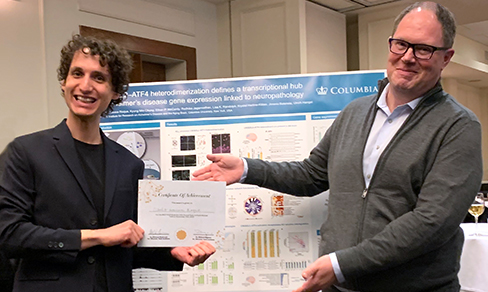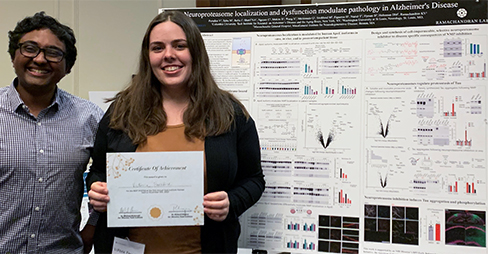Columbia University
Irving Medical Center
Neurological Institute
710 West 168th Street, 3rd floor
(212) 305-1818
TaubCONNECT Research Perspectives:
Best Poster Presentations
Taub Institute Retreat November 2022
CREB3L2-ATF4 Heterodimerization Defines a Transcriptional Hub of Alzheimer's Disease Gene Expression Linked to Neuropathology
Cláudio Gouveia Roque1, Kyung Min Chung1, Ethan P. McCurdy2, Radhika Jagannathan3, Lisa K. Randolph4, Krystal Herline-Killian1, Jimena Baleriola1,5,6,7, Ulrich Hengst1,8,*
1 The Taub Institute for Research on Alzheimer’s Disease and the Aging Brain, Vagelos College of Physicians and Surgeons, Columbia University, New York, NY, USA.
2 Integrated Program in Cellular, Molecular and Biomedical Studies, Vagelos College of Physicians and Surgeons, Columbia University, New York, NY, USA.
3 Division of Aging and Dementia, Department of Neurology, Vagelos College of Physicians and Surgeons, Columbia University, New York, NY, USA.
4 Doctoral Program in Neurobiology and Behavior, Columbia University, New York, NY, USA.
5 Achucarro Basque Center for Neuroscience, Leioa, Spain.
6 IKERBASQUE Basque Foundation for Science, Bilbao, Spain.
7 Department of Cell Biology and Histology, University of the Basque Country, Leioa, Spain.
8 Department of Pathology & Cell Biology, Vagelos College of Physicians and Surgeons, Columbia University, New York, NY, USA.
 Pictured from left to right: Best Poster Winner Cláudio Gouveia Roque, PhD with Ulrich Hengst, PhD (PI).
Pictured from left to right: Best Poster Winner Cláudio Gouveia Roque, PhD with Ulrich Hengst, PhD (PI).Alzheimer’s disease (AD) is a progressive neurodegenerative disorder with an increasing worldwide prevalence. The preclinical phase of AD, which can last 10-20 years, is characterized by the gradual accumulation of β-amyloid and tau aggregates in the brain, together with neuroinflammation and synaptic alterations. Several lines of evidence indicate that β-amyloid deposition precedes and accelerates tau pathology, the latter correlating with the onset of cognitive decline. Concurrently, gene expression changes across specific pathways tied to pathophysiology are observed, highlighting an important role for altered transcriptional regulators in AD. What causes these changes, how they interact with β-amyloid and tau pathologies, and whether they are drivers of disease or a response to it remain, however, unclear.
Here, we discover that β-amyloid promotes the formation of pathological CREB3L2–ATF4 transcription factor heterodimers in neurons. Through a multi-level approach based on AD datasets and a novel chemogenetic method that resolves the genomic binding profile of dimeric transcription factors (ChIPmera), we find that CREB3L2–ATF4 activates a transcription network that interacts with roughly half of the genes differentially expressed in AD, including subsets associated with β-amyloid and tau neuropathologies. CREB3L2–ATF4 activation drives tau hyperphosphorylation and secretion in neurons, in addition to misregulating the retromer, an endosomal complex linked to AD pathogenesis. We further provide evidence for increased heterodimer signaling in AD brain and identify dovitinib as a candidate molecule for normalizing β-amyloid-mediated transcriptional responses. The findings overall reveal differential transcription factor dimerization as a mechanism linking disease stimuli to the development of pathogenic cellular states.
Cláudio Gouveia Roque, PhD
Associate Research Scientist in the Taub Institute
cag2230@cumc.columbia.edu
Neuroproteasome Localization and Dysfunction Modulate Pathology in Alzheimer's Disease
Paradise V1,2, Sabu M1,2, Bafia J3, Sharif NA1,2, Nguyen C1,2, Dhanraj Mukim R1,2, Wang X1,2, Fu J4, Ndubisi J1,2, Maldonado G1,2, Strickland M5, Figueroa H1, Almeida D1,2, Hyman B6, Holtzman DM5, Nuriel T1, Ramachandran KV1,2,7
1 Taub Institute for Research on Alzheimer’s Disease and the Aging Brain, Columbia University
Vagelos College of Physicians and Surgeons, New York, NY 10032
Taub Institute for Research on Alzheimers Disease and the Aging Brain, Columbia University
Vagelos College of Physicians and Surgeons, New York, NY 10032
2 Department of Neurology, Columbia University Irving Medical Center. New York, NY 10032
3 Department of Molecular and Cellular Biology, Harvard University, Cambridge, MA 02139
4 Program in Medical and Population Genetics, Broad Institute of MIT and Harvard, Cambridge,
MA
5 Department of Neurology, Developmental Biology, Hope Center for Neurological Disorders,
Alzheimers Disease Research Center, Washington University School of Medicine, St. Louis, MO
63110
6 Alzheimer Research Unit of the MassGeneral Institute for Neurodegenerative Disease,
Department of Neurology of the Massachusetts General Hospital, and Harvard Medical School,
Charlestown, Massachusetts 02129-4404
7 Department of Neuroscience, Columbia University Vagelos College of Physicians and
Surgeons, New York, NY 10032
 Pictured from left to right: Kapil V. Ramachandran, PhD (PI) with Best Poster Winner Victoria E. Paradise.
Pictured from left to right: Kapil V. Ramachandran, PhD (PI) with Best Poster Winner Victoria E. Paradise.Following the discovery of a neuronal-specific plasma membrane-bound proteasome complex, or NMP, we endogenously tagged NMPs in vivo to reveal that NMPs co-purify with ApoE and Lrp1, defining a novel proteasomal degradation complex in neurons. We find that ApoE4 downregulates NMP localization relative to ApoE3 and ApoE2 in vitro, and in vivo in mouse and human and that NMP mislocalization is specific to regions that are selectively vulnerable in Alzheimer's Disease (AD). To evaluate the consequence of reduced NMP localization, we generated and leveraged chemical tools to selectively inhibit the NMP over the cytosolic proteasome and find that NMP inhibition causes pathological Tau aggregation in vitro and in vivo. We mechanistically link genetic risk factors for AD with protein aggregation through the neuroproteasome and reveal new principles of protein aggregation in neurons.
Victoria E. Paradise
Research Assistant
vp2469@cumc.columbia.edu

